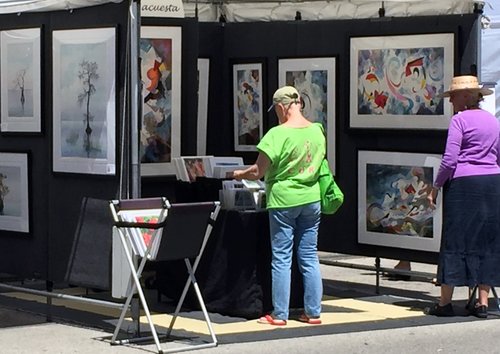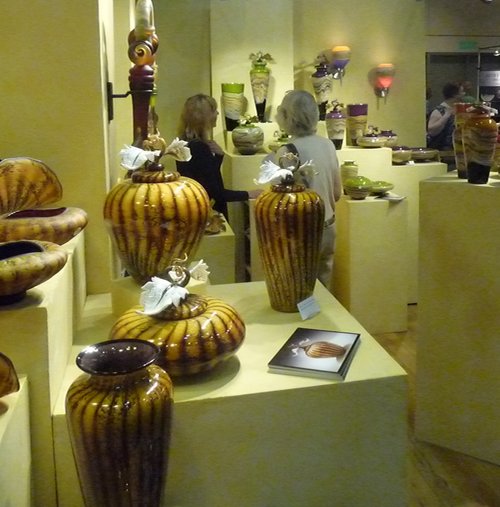by Carolyn Edlund
Exhibiting your work at fairs or festivals this year? Use these booth display tips to maximize impact and sales.

You have seconds to draw in shoppers walk by at a festival. Make your booth display inviting.
Review your booth design carefully.
If you haven’t set up your exhibit booth before, or if you are considering changes in the layout, make a point to set it up in your studio or outdoors before you go to any shows. This will let you know whether you are missing anything (including fixtures, tools, etc.) and will also give you a chance to get a booth photo if you need one. Don’t arrive at a show hoping that you can make an untested booth work on the fly. It usually doesn’t, which only results in problems and unnecessary stress for you.
Keep your booth clutter-free.
Use your display space judiciously, and plan it like a gallery space. When you highlight each piece and give it breathing room, you give it a chance to stand out as significant and special. Less is often more when it comes to presentation. Tables jammed with goods or an overwhelming selection is a turnoff to shoppers. And, it can make your work look like commodity items, and thus less valuable.
If you have lots of inventory, store some in the back to restock as other items sell. This gives you the opportunity to pull out a box with “new” merchandise if you are searching for a certain item. Customers love to be the first to see and purchase goods that haven’t been offered for sale yet.
Use sufficient lighting.
Lighting is essential to display your artwork or handmade products to their best advantage, especially at indoor shows. Poor lighting can kill you sales, while abundant lighting can make your booth attractive and enticing to shoppers. Pack extra lights to have when needed, rather than just throwing a few in your vehicle and hoping they are sufficient.
LED lights are preferred by most artists for their displays. Up to 80% more efficient than traditional bulbs, LEDs cast a clear light without getting hot, which keeps your exhibit booth cool and comfortable. Although LED bulbs are more expensive to purchase, they use less electricity and last longer, making them more cost-effective in the long run.
Make your booth entrance open and inviting.
When you plan your booth layout, avoid creating a narrow entryway. This can cause shoppers to feel “trapped” without an easy exit if they are just browsing and choose to leave. Consider how to set up walls and fixtures to create a traffic flow that encourages people to step into your booth space comfortably.
Use sales aids.
Eye-catching signage can often draw customers to your booth. Enlarge small items with blown-up photographs, or share your tagline to intrigue show attendees. When you hang signs on side walls near the front of your booth, they are visible to shoppers walking down the show aisle toward your booth.
Other sales aids used by artists include video loops shown on a laptop to share technique, “lookbooks” that show wearables on models, or brochures that share artwork in situ. Every piece of information you provide offers you a way to interact with customers. Determine which work best for you, and use them regularly.
Brochures and business cards are traditional sales collateral that can also be effective. It’s best to use them once you engage in conversation with visitors. If a sale is not made, hand them a card personally. At the same time, ask them to sign your guestbook and become a subscriber to your mailing list.

Display work at various levels to add interest and lead the eye.
Eye level is “buy level.”
A multi-level display is often quite effective in a show booth, but this will depend on your medium and the size of your work. Place bestsellers at eye level to make them easy to see. Don’t make shoppers bend down to look at what you make. Bring the display to them by using risers or counters that are raised to an appropriate level.
Make your work accessible.
Touch is an important part of the sale. If your display is set up to allow merchandise to be handled, all the better. If you must use locked cases or displays that discourage touch, keep in mind that you will want to overcome that barrier when you interact with shoppers and invite them to touch and hold the work.
Keep security in mind.
You will be handling money at a show, and your inventory is valuable. Do you have a safe place to keep cash and credit card receipts? Do you need an assistant in your booth to keep an eye on things if you take a break, or to help with sales? Plan ahead to keep your art and your cash safe, so that you can spend your time selling, not worrying.



These are all great points to keep in mind. Especially that we are starting the new show season. Thank you for this information.
Best of luck at the retail shows, Allison!
Carolyn, thank you for all the helpful tips just in time for a festival this weekend!
Best of luck at your show Seetal!